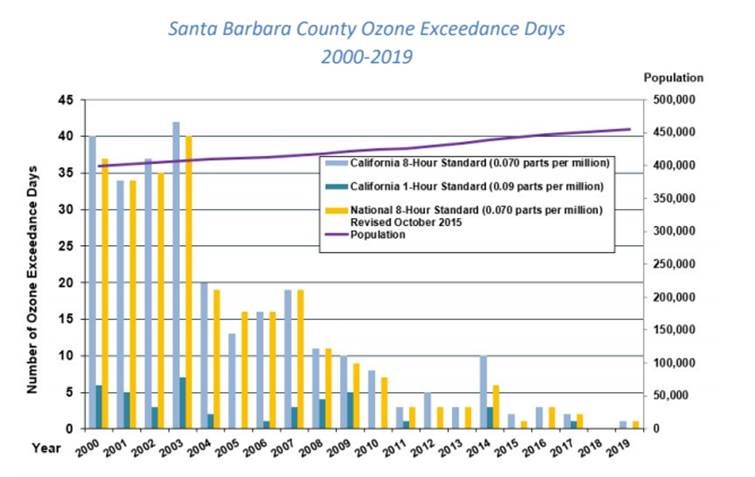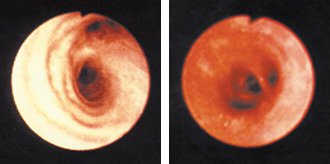Studies have indicated that exposure to ground-level ozone air pollution, even at very low levels, can cause a number of respiratory health effects over time. Santa Barbara County’s ozone season typically runs from April through October. The chart below shows exceedances of current air quality standards from 2000 through 2019 compared with the population growth over the same time period.

Symptoms of Ozone Exposure
When people breathe ozone air pollution, the lining of their lungs can become irritated and inflamed, much like a sunburn on the skin. Other symptoms include:
- coughing
- wheezing
- pain when taking a deep breath
- breathing difficulties during exercise or outdoor activities
Who’s at Risk?
- children who are active outdoors
- adults who work or exercise vigorously outdoors
- people with respiratory diseases such as asthma or emphysema
- people with unusual susceptibility to ozone
Read more on who is at risk.
Actual Risk Factors Depend On:
- current health and susceptibility to ozone
- ozone levels
- length of exposure to polluted air
- breathing rate (or exertion level)
Immediate Problems — Within 24 Hours of Exposure
- respiratory symptoms such as coughing, wheezing, and difficulty breathing as deeply and vigorously as normal
- pain when taking a deep breath
- airway inflammation
- aggravated asthma or other respiratory diseases
- increased susceptibility to respiratory infection
Read more on asthma.
Long-Term Problems
- accelerated aging of the lungs
- diminished lung capacity
- decreased lung function
- aggravated asthma, bronchitis, and emphysema
Health Risks
How does ozone affect health?
Scientists have been studying the effects of ozone on human health for many years. So far, they have found that ozone primarily affects the respiratory system. Roughly one out of three people in the U.S. is at risk of experiencing ozone-related health effects.
Ozone can irritate your respiratory system. When this happens, you might start coughing, feeling an irritation in your throat, and/or experiencing an uncomfortable sensation in your chest. These symptoms can last for a few hours after ozone exposure and may even become painful.
Ozone can reduce lung function. When scientists refer to “lung function,” they mean the volume of air that you draw in when you take a full breath and the speed at which you are able to blow it out.
Ozone may make it more difficult for you to breathe as deeply and vigorously as you normally would. When this happens, you might notice that breathing starts to feel uncomfortable. If you are exercising or working outdoors, you may notice that you are taking more rapid and shallow breaths than normal. Reduced lung function can be a particular problem for outdoor workers, competitive athletes, and others who exercise outdoors.
Ozone can make asthma symptoms worse. When ozone levels are high, more asthmatics have attacks that require a doctor’s attention or the use of additional medication. One reason this happens is that ozone makes people more sensitive to allergens, which are common triggers for asthma attacks. Some of the common asthma triggers are dust mites, cockroaches, pets, mold, and pollen. Asthmatics may also be more severely affected by ozone-induced respiratory irritation and reduced lung function than non-asthmatics.
Ozone can inflame and damage the lining of the lung. Some scientists have compared ozone-caused lung damage to a sunburn. Ozone damages the cells that line the air spaces in the lung. Within a few days, the damaged cells are replaced and the old cells are shed — much in the way skin peels after a sunburn. If this kind of damage occurs repeatedly, it may lead to permanent damage to your lungs that could cause a lower quality of life.

Scientists suspect ozone may cause other health problems. Ozone may aggravate chronic lung diseases, such as emphysema and bronchitis. Studies in animals suggest that ozone also may reduce the immune system’s ability to fight off bacterial infections in the respiratory system. Scientists are concerned that repeated short-term damage from ozone exposure may permanently harm the lung. For example, repeated ozone damage to the developing lungs of children may reduce their lung function when they are adults. In addition, ozone exposure may speed up the decline in lung function that occurs as a natural result of aging.
More on Who is at Risk
Who’s at risk from ground-level ozone?
Four groups of people are particularly sensitive to ozone. These groups become sensitive to ozone when they are active outdoors, because physical activity (such as jogging or outdoor work) causes people to breathe faster and more deeply. During activity, ozone penetrates deeper into the parts of the lungs that are more vulnerable to injury. Sensitive groups include:
1. Children
Active children are the group at highest risk from ozone exposure. Many children spend a large part of their summer vacations outdoors, engaged in vigorous activities either in their neighborhoods or at summer camps.
- Children are also more likely to have asthma or other respiratory illnesses
- Asthma is the most common chronic disease for children and may be aggravated by ozone exposure
- Children’s lungs are still developing, and ozone can harm that development process.
2. Adults who are active outdoors
Healthy adults of all ages who exercise or work vigorously outdoors are considered a “sensitive group” because they have a higher level of exposure to ozone than people who are less active outdoors.
- Healthy adults can experience a 15 to 20 percent reduction in lung function from prolonged exposure to low levels of ozone
- Damage to lung tissue may be caused by repeated exposure to ozone and this could result in reduced quality of life as people age
- Results of animal studies suggest that repeated exposure to ozone for several months or more may produce permanent structural damage to the lungs
3. People with respiratory diseases, such as asthma
Asthma or other chronic respiratory disease make the lungs more vulnerable to ozone’s effects. People with these conditions will generally experience the effects of ozone earlier and at lower levels than less-sensitive individuals.
Read more about asthma.
4. People with unusual susceptibility to ozone
Scientists don’t yet know why, but some healthy people are simply more sensitive to ozone than others. These people may experience more health effects from ozone exposure than the average person. Scientists have studied other groups to find out whether they are at increased risk from ozone. So far, there is little evidence to suggest that either the elderly or people with heart disease have heightened sensitivity to ozone. However, like other adults, elderly people will be at higher risk from ozone exposure if they suffer from respiratory disease, are active outdoors, or are unusually susceptible to ozone as described above.
Asthma
What’s asthma?
- Asthma is a chronic inflammatory disease of the airway
- During an asthma attack, the airways can become so narrow or obstructed that breathing may feel like sucking a thick milkshake through a straw
- Airflow can be limited by: – broncho-constriction (airway narrowing) – inflammation (airway walls get thicker, so airways are narrower) – mucus production
Asthma facts
- Asthma is a growing threat to children and adults.
- Children make up 28 percent of the general population but comprise about 36 percent of the people with asthma.
- Fifteen Americans die every day from asthma, a rate three times greater than just 20 years ago.
- African-Americans die from asthma at a rate three times that of Caucasians.
- Ozone may aggravate asthma, causing more asthma attacks that require increased medication use and increased need for medical care.
- Studies indicate that the number of visits to emergency rooms and the number of hospital admissions increase about 24 hours after ozone levels are high.
More Information
- See What One Person Can Do for Clean Air
- Download additional publications
- See more Health Links on this site
For more information or to request materials, including posters and factsheets, contact the District Public Information Officer, Lyz Hoffman






